One of the smallest pages on your website can also be one of the most important: your About page. And yet, this crucial page is often buried in a drop-down menu or a small link in the footer.
Fifty-five percent of visitors spend fewer than 15 seconds on a website before moving on, according to HubSpot, so you need to give people a reason to care about your site and company. Think of the About page as your company's elevator pitch, or the Cliffs Notes version of your organization (only it's not required reading).
In short, your website needs a great About page, one that will interest visitors, answer questions for customers and provide needed information for reporters. Here are eight elements you should consider including to immediately increase the effectiveness of your company's About page.
1. Company Overview
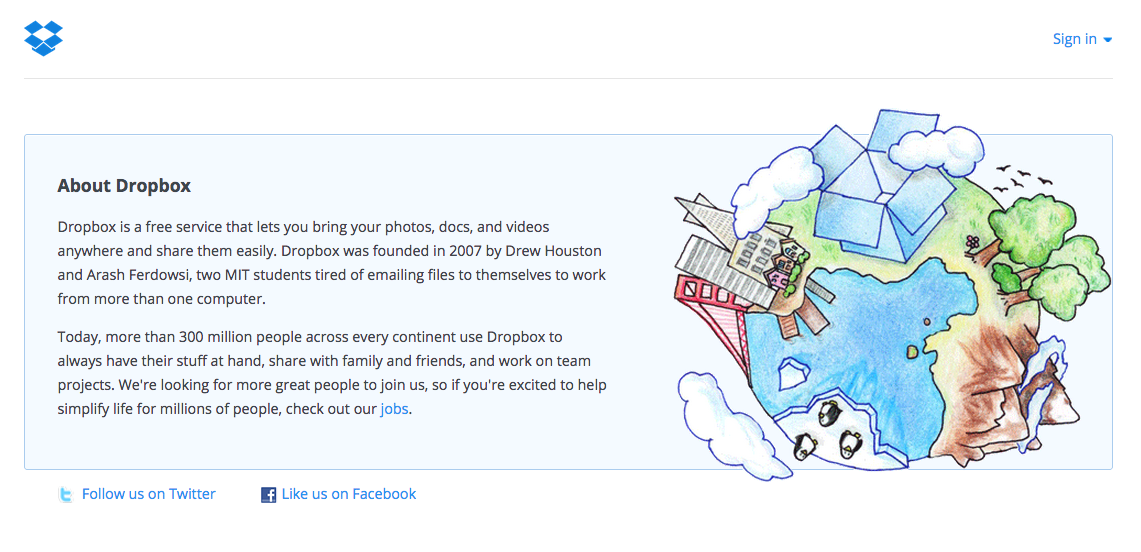
A surprising number of About pages lack the most fundamental pieces of information: the who, what, where, when, why, and how of the business. Those are the reasons people will visit your about page, so you need to present those fact simply, without omitting important information that leaves visitors unfulfilled. But keeping it simple, like Dropbox has done, can actually be pretty complicated.
An introductory blurb (sometimes labeled "Who We Are" or "Our Mission") can range from a very short paragraph to a page-length description, but it should always start with what your company does and—if particular—who you do it for. This is the first thing a visitor to your About page will read, so help them decide quickly if they've found what they are looking for.
It doesn't even have to be that difficult to write an informative About page. Martin Harrison, co-founder of Copify, which provides copywriting services such as website content, advises that the ideal length of a company summary depends entirely on the organization, but he says 400 words is the approximate average. (Dropbox's about copy, for example, is 99 words.)
Whatever the length though, don't forget the basics:
Who are you? Who started your company?
What does your company do? What do you sell?
Where is your company headquartered? Do you have offices elsewhere? Or, where does your company provide services?
When did you start your company? What hours is your business open?
Why did your company start? What's your company's mission?
How does your company help people? How does your product work?
Plenty of companies overlook these essentials. PC and tablet accessories maker Logitech, for example, presents visitors with an overview of the company on their about page, but never outlines what they do or sell. You'll know who they are, but won't know why you should choose their products over another.
But the About page for Burrow's Moving & Storage, a small Chicago-based moving company, immediately describes what kind of services they offer to whom, and where they offer them. Visitors get all the essential information up front, helping them know what makes their service different and why they'd want to choose it.
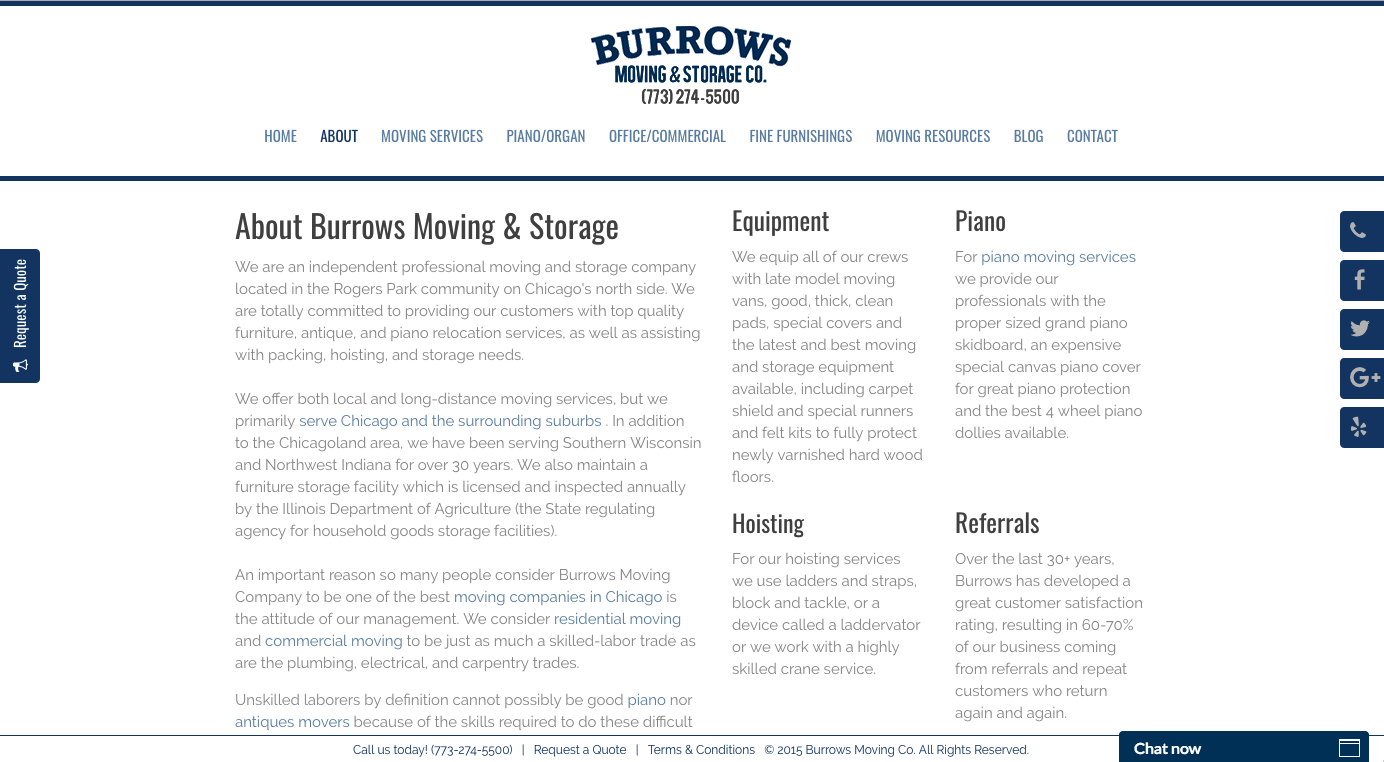
Since the who, what, and why of your business is so important, it's popular to make that the main text of your About page. Then, if you have other important information to share—such as stockholder information, locations, and more—you can put it in subpages or perhaps in a menu located further down or in a sidebar.
2. Relevant Photos and Videos
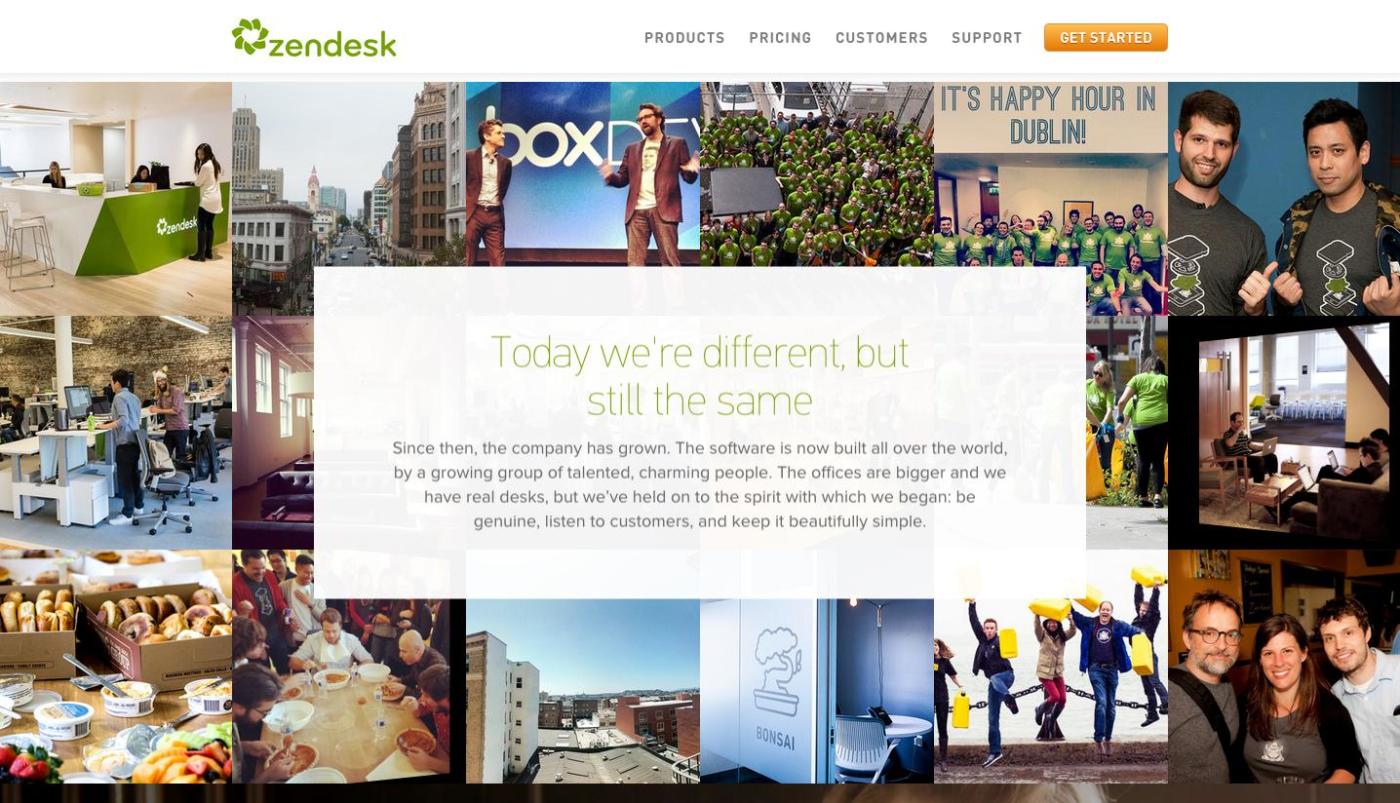
About pages aren't just only filled with text. They're a great place to include photos and videos that help convey your brand company purpose, and perhaps something fun about your team, too. You can include your latest promo video, a photo of your products or headquarters, or some other media that relates what your company is about.
Photos and video let you pack in more information without crowding the page. That's why Austin Paley of Blue Fountain Media says the inclusion of multimedia is not to be underestimated.
"Historically, the About page of any business' website was extremely simple," Paley says. "That's changed in a huge way over the course of the last few years. The 'About Us' page has become something that is more often than not one of the most visually engaging parts of any brand's online presence."
Even stock photos can help get your point across, if they're used thoughtfully. Julia McCoy, founder and CEO of Express Writers, says the media she wove into the company's About page helped set the tone they wanted.
"I went for fun and real with our About page," McCoy says. "I wanted the page to speak to every reader, and really get across how passionate we are about what we do. Hence the Superman style open shirt and 'Real people, delivering real content' for the themed image and slogan at the top of the page."
In addition to the image, Express Writers' About page also includes a brief explainer video. "This animated piece … shows in a nutshell how and why our clients find us a great solution." Prospective clients can quickly glance over the page and get an idea of what it's about, or they can dive into the video for more info.

And if you want visitors to dig even deeper into your company, you can include extra downloadable resources—perhaps a press packet with your company's logo, screenshots or photos of your products, and a PDF guide to your company's offerings. Or, you can offer downloadable industry white papers, guides to using your products, or videos from your conferences or past presentations.
For your press packet, make sure to include your logo in PNG format, as it is the most widely used format and will look best on media sites that cover your company. Also, be sure to specify which logos can be used in which context to align with your brand guidelines. For a great example of a press packet with brand guidelines, check out Dropbox's branding page.
3. Company History
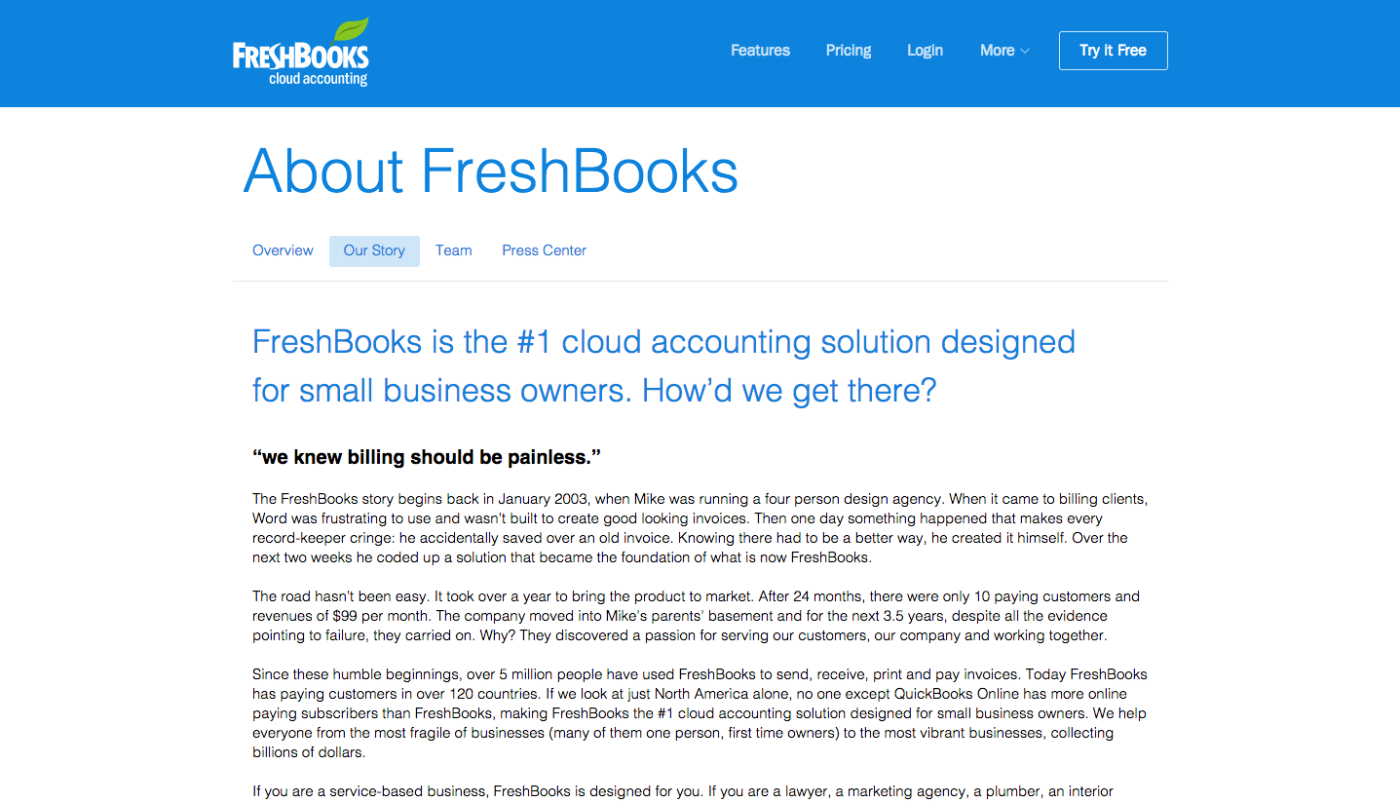
Perhaps your company is a new, one-person show and all you have to say is that you started in your parents garage two years ago. Or maybe you're a small business that has been run by the same family for generations and there are a few paragraphs worth of story to tell.
Either way, saying something about when and how your company began brings a personal aspect to your About page. It shows visitors that you're an established company that's proud of what it's done—either one with a long legacy, or a new company you're asking them to take a chance on.
You'll want to include the year your company was established, when the first signature product was launched, and any other milestones you want to include (including partnerships or rebrandings, for example). But most of all, you'll want to tell why your company was started, sharing enough of the story behind your company to let visitors understand your vision.
There's many ways to go about this. Vodafone UK, to use a large company with a storied history as an example, offers a long and detailed company history that is divided into time periods tabs that contain bullet-pointed info. This makes the information a bit more digestible than writing a long history.

On the other hand, the history page for North Carolina-based Dewey's Bakery knows that you can't have "history" without "story." So, it gives a brief but account of how the business bounced back following a fire destroyed their shop in 1955. That does a great job of connecting with the reader, illustrates the company's love of what it does, and shows that it is a long-established family business that isn't going to call it quits anytime soon.
4. Team Members

Your company's more than a name and products—it's also a team of people that make everything your company does possible. Including the people behind your company lets people place a face with your company, creating a sense of reachability and connection. Plus, it lets you show that you're proud of your team and the work they do.
Including your team on your About page can be one of the more important things you can do. Copify's Harrison said that he sees a lot of companies who don't make reference to any of their team members on their About page.
"For me, that speaks volumes about their attitude towards staff, who are likely not valued or appreciated," Harrison says. "That is not the type of company that I would want to do business with."
Just how many employees to include is a decision that will depend on your company's size. Some companies just highlight their CEOs and top executives, while smaller startups include the whole team. For medium-sized companies, consider including one leader from each department so that the company as a whole is represented and the structure is clear.
Once you've selected who lives on this part of the About page, think about what information you want to include. Some go with a headshot and a title, while others include contact information, social media profiles, and short bios that cover current responsibilities, prior work history and personal interests. The more you include, the more you humanize your brand to the visitor—but just make sure your employees are comfortable with volunteering all the information.
Visuals work here too; aside from headshots, consider a team photo that gives off the vibe of a solid team that operates in your company's well-oiled machine.
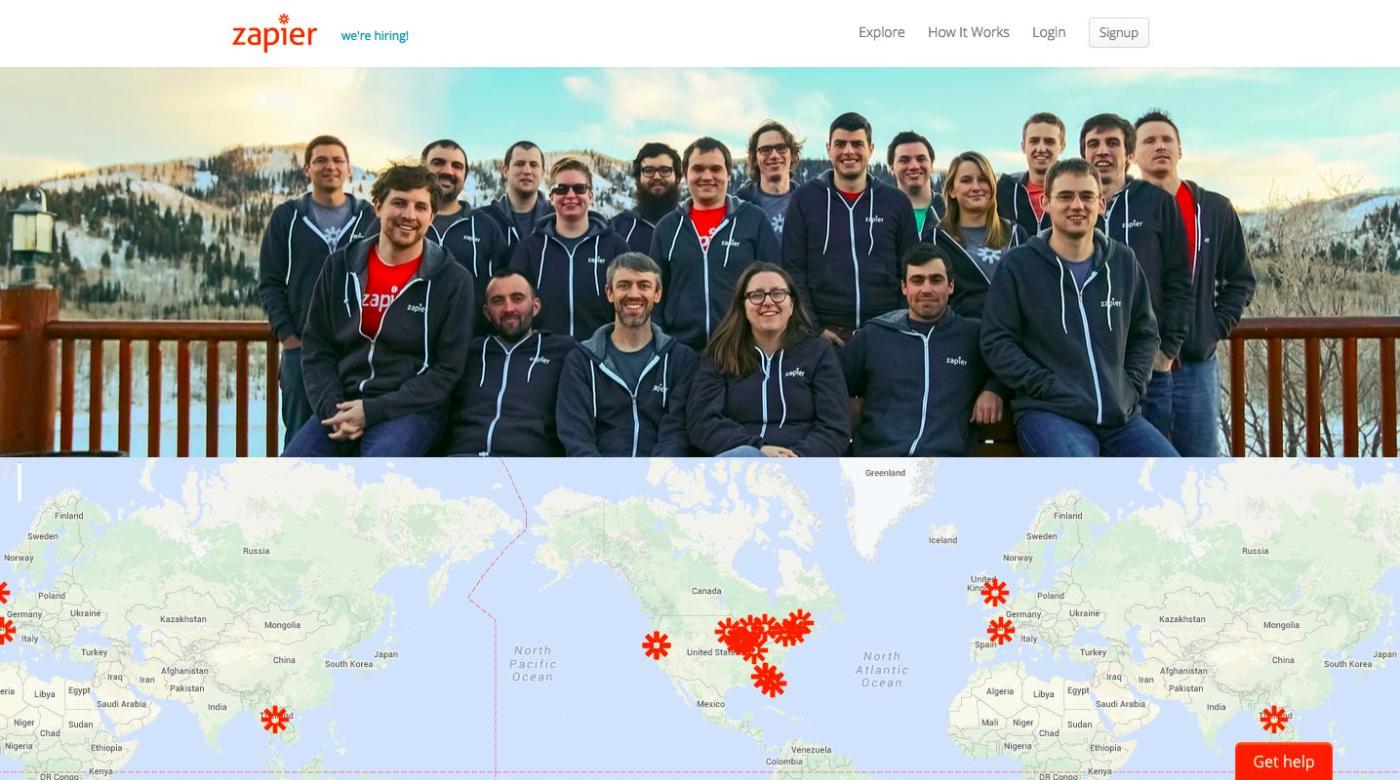
For example, Zapier's own About page is all about team spirit. A team photo (with everyone in matching hoodies at the last company retreat), leads into a map of that shows where Zapier employees are located, followed by headshots with titles and email addresses. It's an easy way to show the team together and share a bit more about each of the people who work at Zapier, along with the rest of the company info.
5. Partners

Your team members aren't the only people important to your company. There's also your partners—the companies you're working with, the apps that integrate with your products, and your investors and advisers. Highlighting these people and companies can boost your reputation, and shows that you're willing to work with others.
For example, education technology company Amplify, which creates digital curriculum for K-12 schools, lists The Lawrence Hall of Science and Common Sense Media as some of their high-profile partners, which brings validity to a high-stakes product. The Food Bank For New York City organizes their partners by category (government, nonprofit, corporate) on their About page, with links to learn more. It's an effective way to show their reach.
If your company is open to forging partnerships, also include information on what you're looking for and who to contact.
6. Customer Testimonials
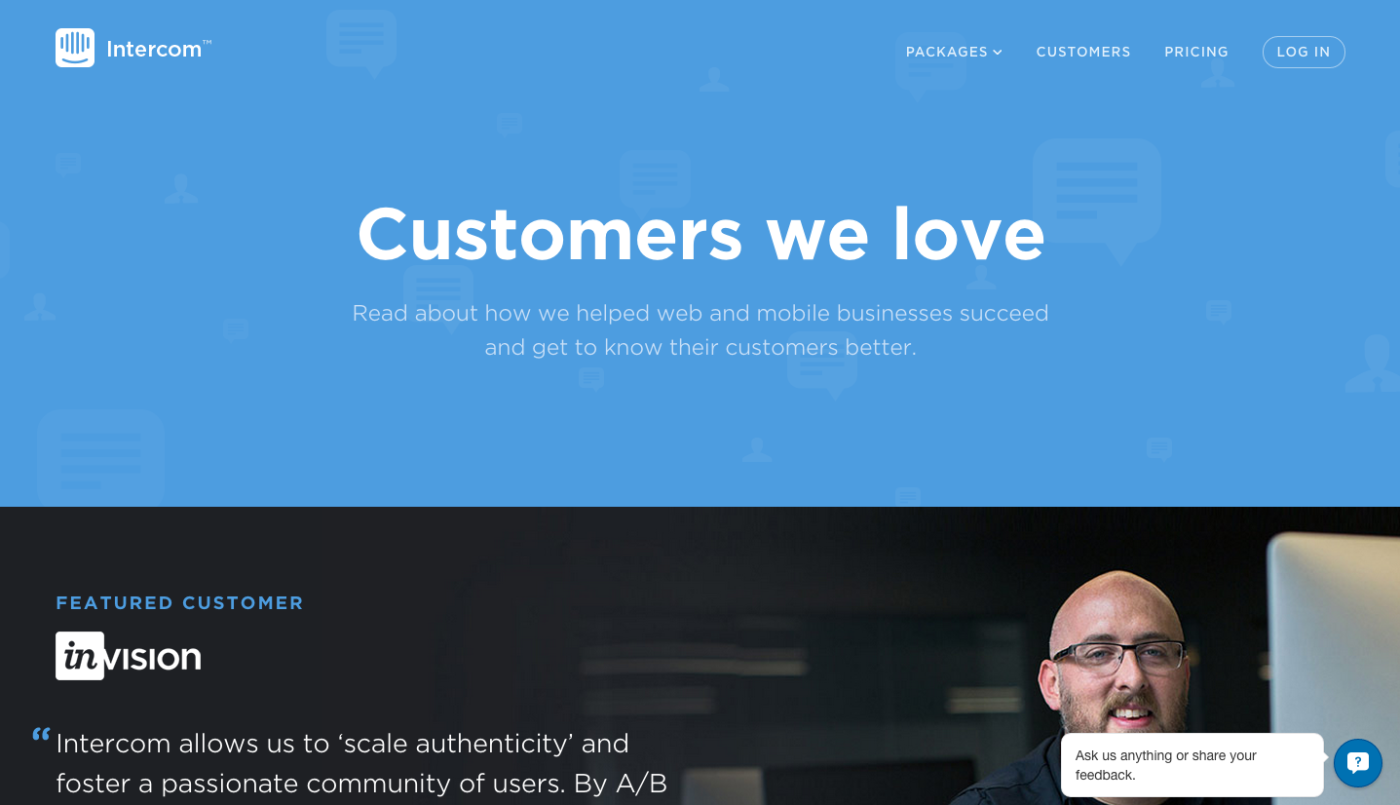
Consumers constantly make choices about where they spend their money based on Yelp reviews, customer ratings and recommendations from friends, rather than flying blind and regretting their choices. Including testimonials on your About page shows not only that you have satisfied customers, but that you have customers who are so satisfied they agreed to be your advocates.
Some companies include customer case studies, with an explanation of how a product or service made their life easier. Others use short customer quotes, similar to reviews on the App Store. Or, you can include links and quotes from positive online reviews or media coverage will work—anything that shows people love and care about your product. Either way, try to include different types of customers and scenarios in your testimonials to appeal to the widest audience and show the breadth of your company's impact.
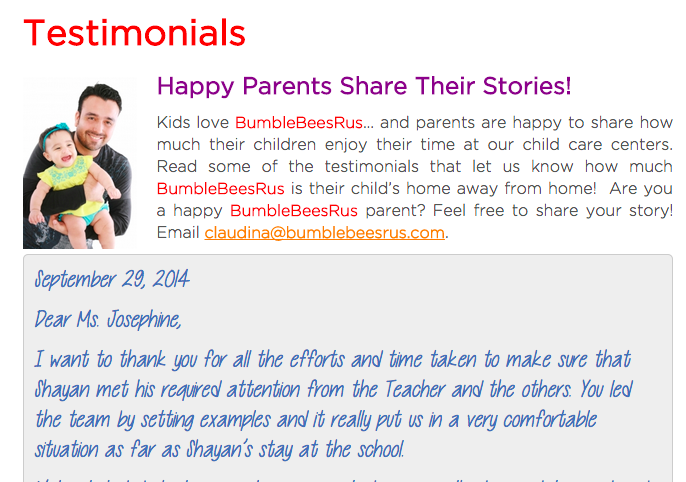
BumbleBeesRUs, a small but successful chain of daycares in New York, has "testimonials" as the first option in its About page. A slew of letters from parents to the company shows that other parents trust the daycare and love what it's doing—something that might help new visitors decide to give their daycare a try.
7. Accomplishments
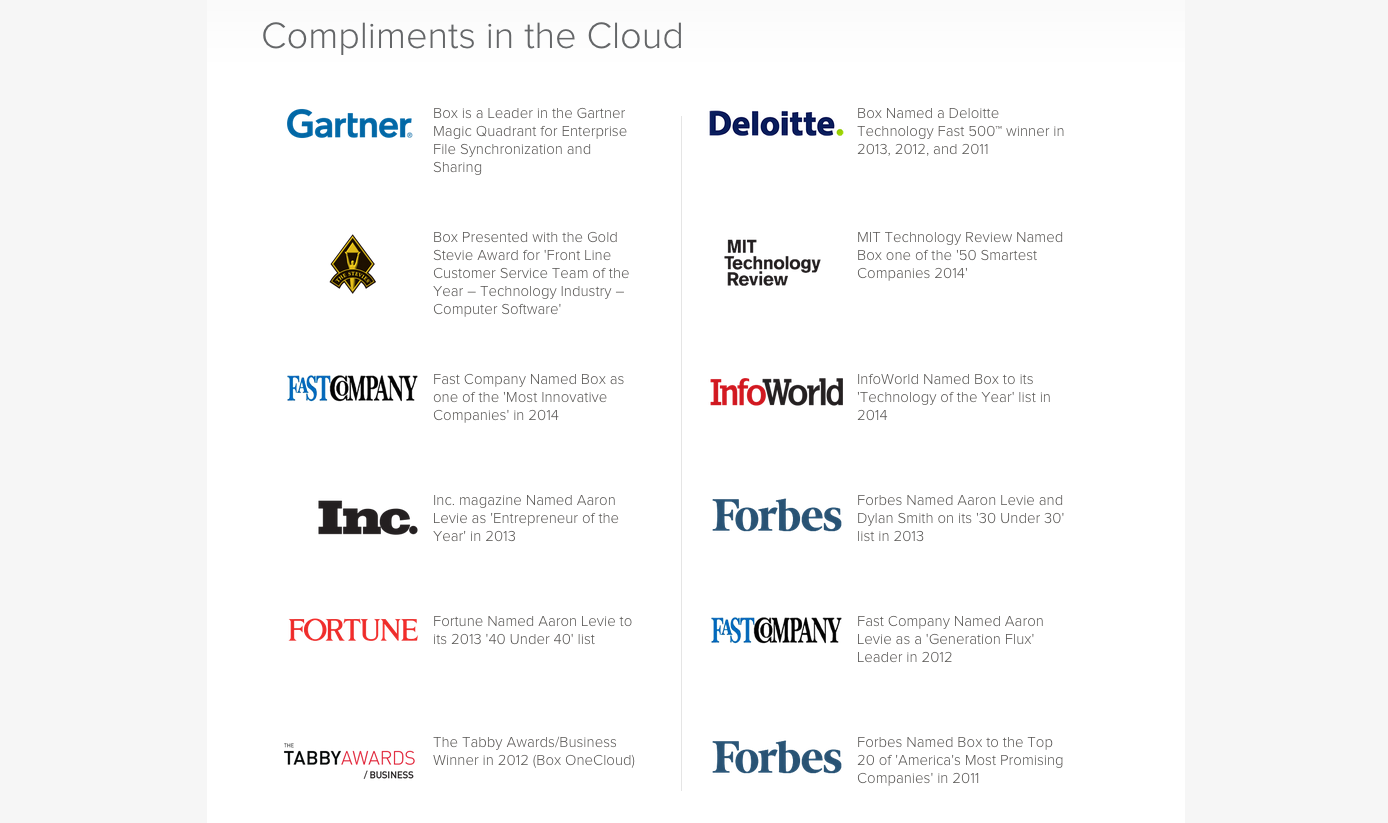
Has your company earned any awards, readers' choice picks, or other recognitions? The About page is a great place to showcase those accomplishments. Similar to testimonials, they are third-party validations that can speak to the quality and effectiveness of what your company does. You should include them in the About page for the record, even if you've already shared them on your blog or press page.
If the accolades your company has received are very industry-specific (e.g. "Gold award for best process control solutions"), include a short explanation of what the award means in layman's terms. You can write out a description of each award, link to the appropriate page on the award grantee's site, and perhaps include a logo or image if appropriate.
Showcasing awards can be a great way to improve visitors' confidence in your products. Biotech company Genentech, for example, lists the 32 awards they've received on their About page, including the year they received them, who gave the award, and links to more information for each one. For a science-centric company, this gives them credibility and helps build trust from the first time you visit their site.
8. Contact Information
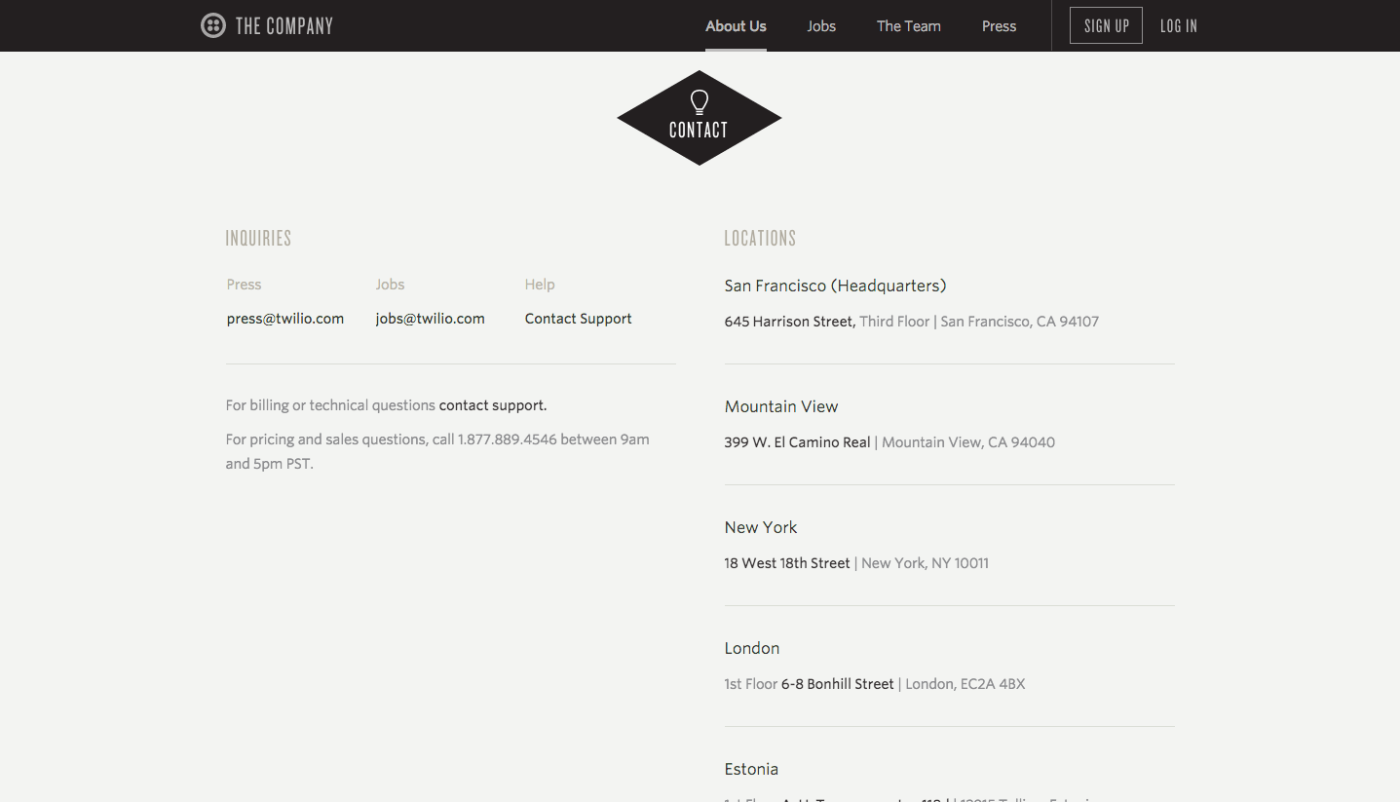
Your About page is so great that your visitor is hooked! Now, how can they reach you?
It may be last on our list, but contact information is one of the most important things you can include in your About page. It doesn't matter where you place the contact info, just make sure it's especially easy to spot. Include every possible way people could get in touch with you: email, phone, social media profiles, chat, and more if available.
Spotify puts the ease of getting in touch first; the first option on their About page menu is for a full page of contact info, including all the addresses of their international offices and how to get in touch with someone about any topic you need. For a team that needs to forge relationships with copyright holders around the world, it's a great strategy that makes them seem open to communications.
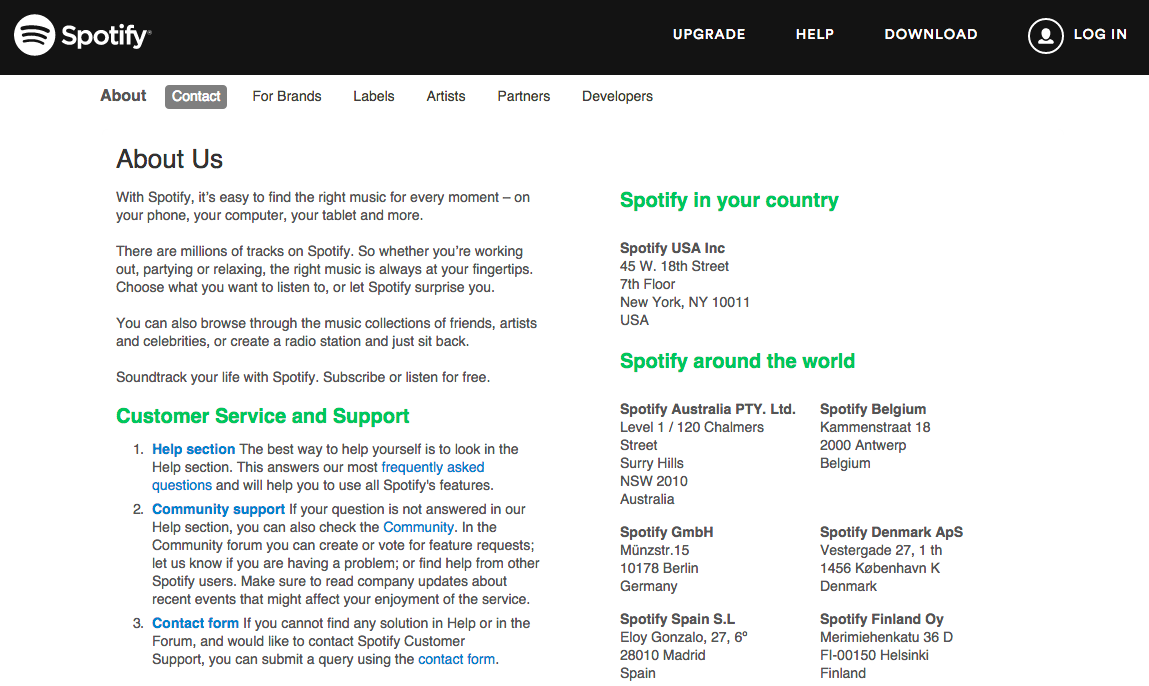
Contact information isn't just important for new business and customer concerns—it's also critical for media inquiries. If your company has a designation public relations representative, make sure to include the rep's name, email and phone number. This way, journalists interested in covering your company—or using you as a source in an article—don't have to go digging. Be sure to include this info near your press kit, if included, as mentioned above.
One more thing you could consider including is a contact form. Rather than having to open their email app to get in touch, visitors can write a message directly to your team without leaving your about page. It's an extra bit of simplicity that might go a long ways in helping people get in touch with you.
Get Creative
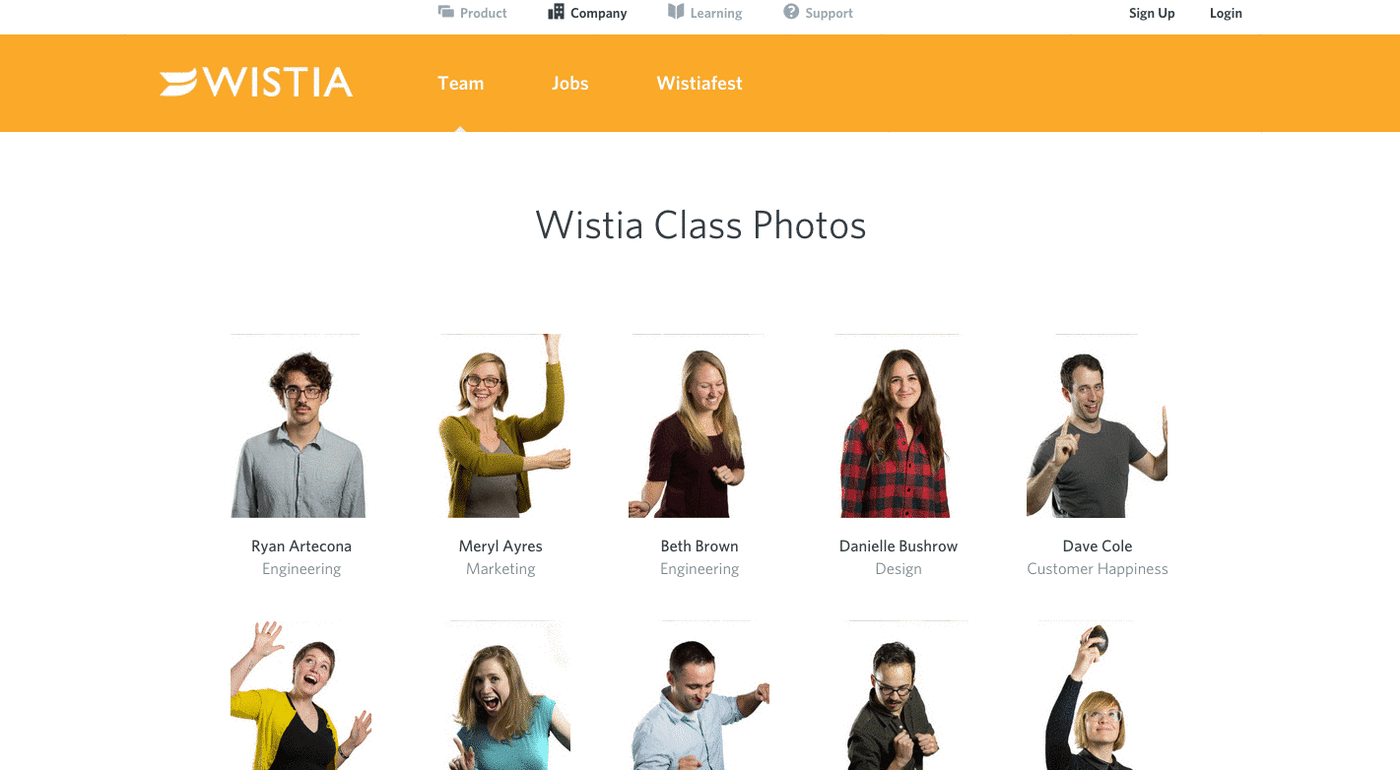
It's not just the last—and least important—page on your site. Your About page is every bit as important as your homepage, and it should get just as much time, attention, and care. But your About page doesn't need to be the exact same as everyone else's. Instead, pull the sections of this article that apply most to your business, then add some creativity. Do something unique that'll bring visitors delight when they land on your About page and you'll soon possess one of the most important brand assets you could ask for.
What company has your favorite About page? Or what's unique about your company's About page? We'd love to hear about both in the comments below.





